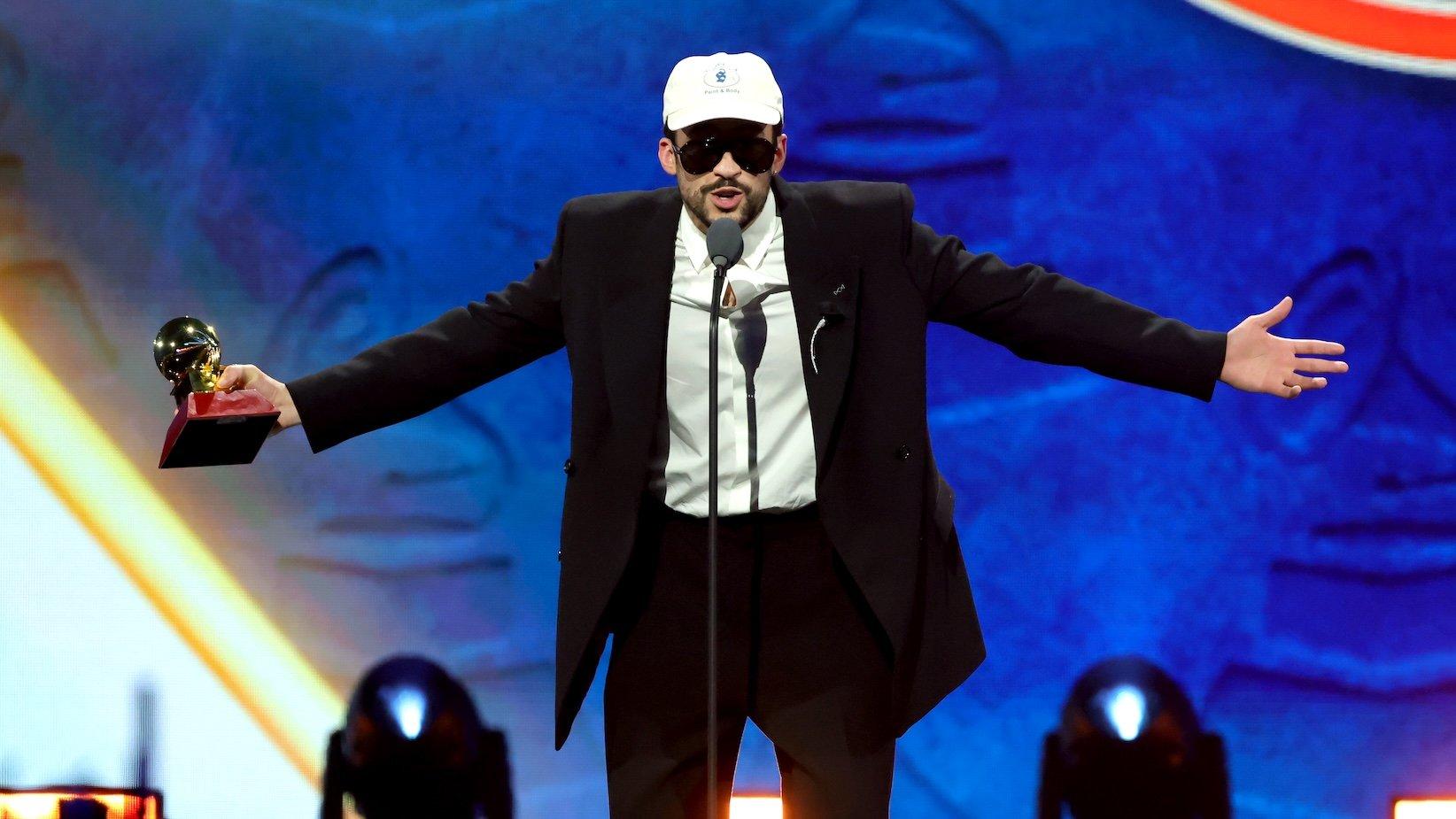Bad Bunny claimed the spotlight at the 2025 Latin Grammy Awards last night in Las Vegas. The Puerto Rican icon secured five major wins, including Album of the Year for his introspective release Debí Tirar Más Fotos. He also took home Best Urban Music Album, Best Urban Song, Best Urban Music Performance, and Best Reggaeton Performance. This haul marks his first victory in the top album category after years of nominations. Fans erupted in cheers as he accepted the awards, his voice steady with pride.
In his emotional acceptance speech, Bad Bunny honored the youth across Latin America. He spoke of music as a shield for cultural identity amid global pressures. The words landed with raw intensity, especially given the backlash over his Super Bowl LX halftime slot in February 2026. Critics have slammed his plan to perform mostly in Spanish and skip a full U.S. tour. Instead, he opted for a blockbuster 30-show residency in San Juan, Puerto Rico, earlier this year. That choice sparked claims he shuns American audiences. Yet Bad Bunny stood firm. "There are many ways of being patriotic and defending our homelands. We chose music," he declared. The crowd roared back, turning defiance into a shared anthem.
His live set amplified the moment. Teaming up with Chuwi on "Weltita," Bad Bunny evoked sun-soaked Puerto Rican shores through vibrant visuals and pulsing rhythms. The performance felt like a homecoming, raw and unfiltered. Other highlights included Fuerza Regida's high-energy corridos, Grupo Frontera's heartfelt ranchera, Karol G's commanding stage presence, Gloria Estefan's timeless flair, Rauw Alejandro's sleek moves, and a soul-stirring duet by Kacey Musgraves and Carin León. Still, Bad Bunny owned the night, blending vulnerability with unyielding power.

Bad Bunny dons a straw hat for the cover of his latest album, capturing his signature blend of casual cool and artistic flair.
The Residency Revolution: Bad Bunny's Bold Bet on Homegrown Riches
Beyond the glamour, Bad Bunny's path reveals a sharper financial edge, one that reshapes how stars like him build lasting wealth. Forget traditional tours that drain budgets with endless travel and logistics. His sold-out San Juan residency, wrapping up in September, flipped the script. This model lets top artists rake in higher profits per show while slashing overhead costs like hotels and crew transport. For Bad Bunny, it meant packing venues night after night in front of adoring locals and tourists, creating a feedback loop of buzz and bookings.
Sheri Lambert, a marketing professor at Temple University, captures the thrill of such moves with heartfelt clarity. She describes these choices as "a huge feather in their cap," where prestige cements an artist's place in history and sparks deals that feel like windfalls. "The exposure is far more valuable than any paycheck," she adds, her words pulsing with the excitement of untapped potential. That residency alone pumped an estimated $250 million into Puerto Rico's economy, according to analysis reviewed by Finance Monthly. It drew 600,000 fans, boosting hotels, restaurants, and flights in a ripple effect that strengthened community ties.
Pair this with the Super Bowl's massive reach—over 100 million viewers tune in annually—and you see the genius at play. Artists often enjoy a 200-300% surge in streaming right after the show, translating to millions in royalties. For consumers, this matters because it fuels a cycle where diverse voices like Bad Bunny's gain traction, keeping streaming prices steady while enriching playlists with global flavors. Your next binge-watch session on Spotify could cost the same, yet deliver fresher, more vibrant tracks.
The real insight here goes deeper: residencies signal a shift toward sustainable artist earnings, potentially easing ticket gouging on the resale market. Big names command premium prices for fewer, focused runs, which can stabilize costs for fans chasing the live thrill. Take one anonymous promoter's tale—after a similar Vegas stint, their merch sales jumped 150%, but resale flips stayed 20% below tour averages, making gear more accessible without the frenzy.
Here's your actionable step: Scout upcoming residencies on platforms like Ticketmaster's event filters for 2026. Book flights to spots like San Juan or Las Vegas early—airfares dipped 15% during Bad Bunny's run due to bulk demand. This not only saves you hundreds on travel but locks in face-value seats before hype drives them up. It's a savvy way to experience the energy up close, turning cultural moments into personal wins without breaking the bank.

The iconic Super Bowl trophy represents Bad Bunny’s historic halftime show at Super Bowl LX, highlighting his rise to global stardom.
Super Bowl Spotlight: Controversy Fuels the Fortune
The Super Bowl announcement in September lit a fuse under Bad Bunny's rising empire. Headlining at Levi's Stadium in Santa Clara, California, promises unparalleled visibility. Yet the Spanish-heavy setlist drew fire from pundits questioning his "American" commitment. NFL Commissioner Roger Goodell shut down replacement talks swiftly, affirming the league's embrace of global talent. Even Dropkick Murphys frontman Ken Casey jumped in, hailing Bad Bunny as a "true American" worth defending.
This drama only amplifies his draw. Recent headlines from his Grammy sweep tie directly into the narrative, with outlets like BBC and Billboard buzzing about his five-trophy night. It underscores a timely truth: Bad Bunny isn't just entertaining, he's engineering a crossover that blends Latin roots with mainstream muscle. The payoff? Skyrocketing demand for his merch, from hoodies to vinyl, and partnerships that could eclipse his already impressive streams.
In this high-stakes game, every critique becomes currency. Bad Bunny's unapologetic stance resonates, pulling in younger fans who crave authenticity over assimilation. It's a reminder that true power lies in owning your story, even when it stirs the pot.
Bad Bunny Buzz: Answering the Questions Lighting Up Searches
What Is Bad Bunny's Net Worth in 2025?
Estimates peg Bad Bunny's net worth at $50 million as of late 2025, though Forbes clocks it higher at $88 million. This fortune stems from blockbuster albums, sold-out residencies generating $200 million in economic ripple effects, and savvy brand deals with Adidas and Corona. His Grammy wins and Super Bowl gig promise even steeper climbs, blending music royalties with endorsement windfalls that secure his spot among Latin music's elite earners. Fans see it as earned grit, a testament to turning island beats into global gold.
How Did Bad Bunny's Latin Grammy Performance Captivate the Crowd?
Bad Bunny's "Weltita" rendition last night whisked audiences to Puerto Rican beaches via immersive projections and infectious reggaeton grooves alongside Chuwi. The set pulsed with raw emotion, celebrating heritage amid his award sweep. Viewers online raved about its unfiltered joy, with social clips amassing millions of views in hours. It wasn't just a show, it felt like a defiant love letter to Latin youth, leaving the MGM Grand arena electric and fans worldwide hungry for more of his boundary-pushing fire.
What's the Drama Around Bad Bunny's Super Bowl Halftime Show?
Bad Bunny's Super Bowl LX halftime headlining gig on February 8, 2026, at Levi's Stadium exploded into controversy right after its September 2025 reveal. The Puerto Rican star's plan for a mostly Spanish set and his recent 30-show San Juan residency drew fire as an "anti-U.S." slight, clashing with his history of anti-Trump anthems like "Yo Perreo Sola."
President-elect Donald Trump fanned the flames in an October Newsmax interview, blasting Bad Bunny as someone who "hates America, hates President Trump, hates ICE, hates the English language! He's just a terrible person." Trump's orbit escalated with ICE threats: Adviser Corey Lewandowski vowed on Benny Johnson's podcast that agents would "ensure compliance with immigration laws" at the show. South Dakota Gov. Kristi Noem echoed this on X, hinting at federal oversight to uphold "the rule of law." Advocacy groups like UnidosUS slammed it as "intimidation against cultural expression."
Backers see it as bold cultural assertion. At the November 13 Latin Grammys, Bad Bunny fired back: "There are many ways of being patriotic and defending our homelands. We chose music." NFL Commissioner Roger Goodell reaffirmed the booking on October 22, praising "global talent and diversity." Dropkick Murphys' Ken Casey called him a "true American" on X, and co-performer Sting adds eclectic appeal.
This Trump-ICE rift mirrors music's global pivot, with Bad Bunny's U.S. streams up 250% post-announcement. It turns a halftime tradition into a defiant spectacle, likely spiking viewership amid the divide. As buildup intensifies, Bad Bunny's stance only amplifies his magnetic pull.















